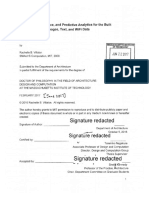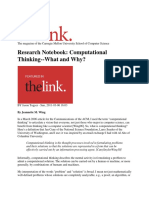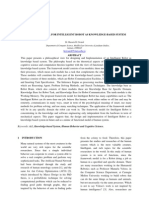IC13SEPT2011
IC13SEPT2011
Uploaded by
Rahul KalathilCopyright:
Available Formats
IC13SEPT2011
IC13SEPT2011
Uploaded by
Rahul KalathilOriginal Description:
Copyright
Available Formats
Share this document
Did you find this document useful?
Is this content inappropriate?
Copyright:
Available Formats
IC13SEPT2011
IC13SEPT2011
Uploaded by
Rahul KalathilCopyright:
Available Formats
IIT Bombay is organising an Institute Lecture on Tuesday, September 13, 2011.
The details are as follows:
Speaker
Prof. B. Chandrasekharan Professor Emeritus, Senior Research Scientist and Director AI Research Laboratory , Department of Computer Science & Engineering Ohio State University
Title Day & Date Time Venue
: : : :
Diagrammatic Reasoning Giving Perception Its Due in Thinking Tuesday, September 13, 2011 5.15 p.m. Lecture Hall No. 22, Victor Menezes Convention Centre
All are invited.
----------------------------------------------------------------------------------------------------------------------------Abstract: Artificial Intelligence (AI) and cognitive science by and large subscribe to the "Language of Thought" hypothesis, which treats thinking as taking place on a representational substrate made up expressions composed of symbolic predicates. Thus, in much AI work on problem solving as goaldirected reasoning, goals, knowledge, and problem states are all taken to be such representations. On the other hand, phenomenological accounts of our own thought reveal that the cognitive state is multimodal: In addition to the linguistic component, we also experience, as part of our cognitive state, perceptual images in different modalities. Diagrammatic representations are often a significant component of such cognitive states, and play a role in problem solving. External representations in the form of diagrams are ubiquitous in modern cultures. In this talk, Prof. Chandrasekharan describes a bimodal architecture for problem solving in which diagrams and predicate symbolic representations are co-equal representational modes. Problem solving proceeds opportunistically whichever modality can solve a subgoal makes its contribution at each cycle. A set of perceptual routines recognize emergent objects and evaluate a set of generic spatial relations between objects in a diagram; and a set of action routines create or modify the diagram in the service of problem solving goals. The work on diagrammatic representations suggests what a more fully developed multi-modal cognitive architecture would look like. About the Speaker: Prof. B. Chandrasekaran is Professor Emeritus, Senior Research Scientist and Director of the Laboratory for AI Research in the Department of Computer & Information Science at Ohio State University. His major research activities have been in knowledge-based reasoning (especially causal understanding as applied to design and diagnosis), image-based reasoning, architecture of mind, and cognitive science. His work on generic tasks in knowledge-based systems is among the most heavily cited in recent research in the area of knowledge-based systems, as is his work on engineering design and functional reasoning. His current focus is on causal understanding and use of images in problem solving. Prof. Chandrasekaran was Editor-in-Chief of IEEE Expert from 1990 to 1994. He co-edited Diagrammatic Reasoning: Cognitive and Computational Perspectives (AAAI Press/ The MIT Press, 1995). From July 2001-Dec 2009, he was part of the US Army Research Laboratories Collaborative Technology Alliance on Advanced Decision Architectures, which supported his group's research on diagrammatic reasoning, decision architectures and information fusion. He has been elected Fellow of IEEE, AAAI and ACM.
You might also like
- MADE EASY Previous Years GATE Book PDFDocument309 pagesMADE EASY Previous Years GATE Book PDFGaddam Sudheer80% (5)
- ECE JU Curriculum Re NumberedDocument322 pagesECE JU Curriculum Re NumberedAnand Acahri100% (4)
- Foundations of Computer Vision: Intelligent Systems Reference Library March 2017Document18 pagesFoundations of Computer Vision: Intelligent Systems Reference Library March 2017harrouche riadhNo ratings yet
- Cognitive Architectures and Multi-Agent Social SimulationDocument15 pagesCognitive Architectures and Multi-Agent Social SimulationEmaaaanNo ratings yet
- IEEEICCICC12 KN BrainInformaticsDocument3 pagesIEEEICCICC12 KN BrainInformaticsIm GrootNo ratings yet
- Analysis of A Top-Down Bottom-Up Data Analysis Framework and Software Architecture Design - 11484 - 22-09-08-14-48-54-I4wxbDocument72 pagesAnalysis of A Top-Down Bottom-Up Data Analysis Framework and Software Architecture Design - 11484 - 22-09-08-14-48-54-I4wxbPatricio MunozNo ratings yet
- Cognitive Architectures and Multi-Agent Social SimulationDocument15 pagesCognitive Architectures and Multi-Agent Social SimulationisraaNo ratings yet
- Rossol Nathaniel Spring+2010Document58 pagesRossol Nathaniel Spring+2010Hamdy RagbNo ratings yet
- Seminar ReportDocument18 pagesSeminar ReportAll About Youtuber'sNo ratings yet
- Narration of Light:: Computational Tools For Framing The Tonal ImaginationDocument108 pagesNarration of Light:: Computational Tools For Framing The Tonal ImaginationMukesh WaranNo ratings yet
- FINAL - MINI - PROJECT Report 2 (Document18 pagesFINAL - MINI - PROJECT Report 2 (aryapatil624No ratings yet
- L 0016872142 PDFDocument28 pagesL 0016872142 PDFDona ChatterjeeNo ratings yet
- Artificial Intelligence in Construction Engineering and ManagementDocument271 pagesArtificial Intelligence in Construction Engineering and ManagementMárcia BibianoNo ratings yet
- Mandatory Reading 00 3438581Document26 pagesMandatory Reading 00 3438581AgalievNo ratings yet
- Seminar On Artificial Intelligence: Gagan Singh Session: 2018-2019Document20 pagesSeminar On Artificial Intelligence: Gagan Singh Session: 2018-2019Gagan Singh ThenuaNo ratings yet
- 2014, Ontology COKBDocument20 pages2014, Ontology COKBthanhnh271188No ratings yet
- Artificial Intelligence and Software Engineering SDocument9 pagesArtificial Intelligence and Software Engineering SEnrike HernandezNo ratings yet
- This Content Downloaded From 77.215.170.203 On Wed, 29 Sep 2021 13:46:57 UTCDocument17 pagesThis Content Downloaded From 77.215.170.203 On Wed, 29 Sep 2021 13:46:57 UTCNancy Al-AssafNo ratings yet
- The Scandinavian Journal of Economics, Wiley Ekonomisk TidskriftDocument26 pagesThe Scandinavian Journal of Economics, Wiley Ekonomisk TidskriftJaneNo ratings yet
- Object Detection11Document23 pagesObject Detection11asha.py81No ratings yet
- ICCSA12 Keynote CogComputers YWDocument1 pageICCSA12 Keynote CogComputers YWHelmi Murad Abdul HamidNo ratings yet
- Computer Science Research Methodologies PDFDocument3 pagesComputer Science Research Methodologies PDFMire GamboaNo ratings yet
- Computer Vision Literature ReviewDocument6 pagesComputer Vision Literature Reviewea8d1b6n100% (1)
- Unesco - Eolss Sample Chapters: Knowledge Based System Development ToolsDocument10 pagesUnesco - Eolss Sample Chapters: Knowledge Based System Development ToolsjeeturathiaNo ratings yet
- University Institute of Technology Rajiv Gandhi Proudyogikivishwavidyalaya Bhopal (M.P.)Document44 pagesUniversity Institute of Technology Rajiv Gandhi Proudyogikivishwavidyalaya Bhopal (M.P.)Mahak JoshiNo ratings yet
- Informatics Research Center FINALDocument8 pagesInformatics Research Center FINALErvin KamberoskiNo ratings yet
- Embodied IntelligenceDocument31 pagesEmbodied IntelligenceNagendra KumarNo ratings yet
- B Villalon, Rachelle. 2008. Data Mining, Inference, and Predictive Analytics For The Built Environment With Images, Text, WiFi Data PDFDocument195 pagesB Villalon, Rachelle. 2008. Data Mining, Inference, and Predictive Analytics For The Built Environment With Images, Text, WiFi Data PDFSonya HaerdyNo ratings yet
- The Architecture and Evolution of Computer Game EnginesDocument34 pagesThe Architecture and Evolution of Computer Game EnginesEmilioMoranPilliguaNo ratings yet
- (Sayama) Introduction To The Modeling and Analysis of Complex Systems PDFDocument498 pages(Sayama) Introduction To The Modeling and Analysis of Complex Systems PDFDiego67% (3)
- Softwar A Novel Theory On Power Projection (1) - 001-100Document100 pagesSoftwar A Novel Theory On Power Projection (1) - 001-100Luis fernandesNo ratings yet
- Stanford SampleDocument4 pagesStanford Samplekhosravi.s998No ratings yet
- Soft WarDocument400 pagesSoft WarllcooljNo ratings yet
- Artificial IntelligenceDocument472 pagesArtificial IntelligenceStudy MailNo ratings yet
- Handout 1 DDDDVDVDVDFDDDocument14 pagesHandout 1 DDDDVDVDVDFDDag2896323No ratings yet
- Final PresentationDocument13 pagesFinal PresentationAjeet SinghNo ratings yet
- Ai Tecuci WIREDocument21 pagesAi Tecuci WIREselamawitNo ratings yet
- Handwritten Character Recognition (HCR) USING NEURAL NETWORKDocument76 pagesHandwritten Character Recognition (HCR) USING NEURAL NETWORKAnimesh PrasadNo ratings yet
- Internship Report (206232)Document19 pagesInternship Report (206232)priyanka jadhavNo ratings yet
- HCI Notes - Unit 5Document7 pagesHCI Notes - Unit 5MadhukarNo ratings yet
- Brains Machines and Buildings Towards A Neuromorphic ArchitectureDocument23 pagesBrains Machines and Buildings Towards A Neuromorphic ArchitectureThisciNo ratings yet
- CT What and WhyDocument8 pagesCT What and WhyKathleenNo ratings yet
- Cognitive Architectures in HCI - Present Work and Future DirectionsDocument10 pagesCognitive Architectures in HCI - Present Work and Future DirectionsizandmNo ratings yet
- AI Handbook FA2021Document9 pagesAI Handbook FA2021Hamza ShahNo ratings yet
- Indoor Positioning Using Inertial Measurement UnitsDocument1 pageIndoor Positioning Using Inertial Measurement UnitsmailtosshettyNo ratings yet
- Framework Model For Intelligent Robot As Knowledge-Based SystemDocument7 pagesFramework Model For Intelligent Robot As Knowledge-Based SystemUbiquitous Computing and Communication JournalNo ratings yet
- HCI and User-Experience Design PDFDocument285 pagesHCI and User-Experience Design PDFraj123789No ratings yet
- From Design Concepts To Design Descriptions: International Journal of Architectural Computing September 2008Document27 pagesFrom Design Concepts To Design Descriptions: International Journal of Architectural Computing September 2008Baha Eddine LadhariNo ratings yet
- Industrial Training Report: June - July 1997Document67 pagesIndustrial Training Report: June - July 1997Aditi GuptaNo ratings yet
- Handwritten Character Recognition (HCR) USING NEURAL NETWORKDocument76 pagesHandwritten Character Recognition (HCR) USING NEURAL NETWORKTanmayNo ratings yet
- Visual Mental Imagery: A View From Artificial IntelligenceDocument47 pagesVisual Mental Imagery: A View From Artificial IntelligenceflaviasmansanoNo ratings yet
- Systems Engineering Demystified: Apply modern, model-based systems engineering techniques to build complex systemsFrom EverandSystems Engineering Demystified: Apply modern, model-based systems engineering techniques to build complex systemsRating: 4 out of 5 stars4/5 (1)
- Practical Mathematics for AI and Deep Learning: A Concise yet In-Depth Guide on Fundamentals of Computer Vision, NLP, Complex Deep Neural Networks and Machine Learning (English Edition)From EverandPractical Mathematics for AI and Deep Learning: A Concise yet In-Depth Guide on Fundamentals of Computer Vision, NLP, Complex Deep Neural Networks and Machine Learning (English Edition)No ratings yet
- Computational Modeling of Tensegrity Structures: Art, Nature, Mechanical and Biological SystemsFrom EverandComputational Modeling of Tensegrity Structures: Art, Nature, Mechanical and Biological SystemsNo ratings yet
- The Autonomous System: A Foundational Synthesis of the Sciences of the MindFrom EverandThe Autonomous System: A Foundational Synthesis of the Sciences of the MindNo ratings yet
- Building Support Structures, 2nd Ed., Analysis and Design with SAP2000 SoftwareFrom EverandBuilding Support Structures, 2nd Ed., Analysis and Design with SAP2000 SoftwareRating: 4.5 out of 5 stars4.5/5 (15)
- System Verilog Assertions and Functional Coverage: Guide to Language, Methodology and ApplicationsFrom EverandSystem Verilog Assertions and Functional Coverage: Guide to Language, Methodology and ApplicationsNo ratings yet
- Indofab Industries SparesDocument35 pagesIndofab Industries SparesRahul KalathilNo ratings yet
- Indofab Industries DriveheadDocument8 pagesIndofab Industries DriveheadRahul KalathilNo ratings yet
- Kickass TorrentsDocument10 pagesKickass TorrentsRahul KalathilNo ratings yet
- Performance Review TemplateDocument4 pagesPerformance Review TemplateRahul KalathilNo ratings yet
- Energy Scenario in INDIADocument3 pagesEnergy Scenario in INDIARahul KalathilNo ratings yet
- February 15 IL5 PMDocument1 pageFebruary 15 IL5 PMRahul KalathilNo ratings yet
- ColloquimDocument1 pageColloquimRahul KalathilNo ratings yet
- Wage AdministrationDocument8 pagesWage AdministrationRahul KalathilNo ratings yet
- April 6 IC2011Document1 pageApril 6 IC2011Rahul KalathilNo ratings yet
- TLSWeb 27 Aug 2012Document1 pageTLSWeb 27 Aug 2012Rahul KalathilNo ratings yet
- February 11 I C 2011Document1 pageFebruary 11 I C 2011Rahul KalathilNo ratings yet
- All Are Invited.Document1 pageAll Are Invited.Rahul KalathilNo ratings yet
- Wind Power Plants: Submitted byDocument38 pagesWind Power Plants: Submitted byRahul KalathilNo ratings yet
- Rolling Operations: ExperimentDocument12 pagesRolling Operations: ExperimentSaurav ParmarNo ratings yet
- Detailed Report On Dhule Wind Power PlantDocument3 pagesDetailed Report On Dhule Wind Power PlantRahul KalathilNo ratings yet
- Client Side CommandsDocument17 pagesClient Side CommandsRahul KalathilNo ratings yet
- Machine Design - I COPODocument5 pagesMachine Design - I COPOrajdecoratorsNo ratings yet
- Bachelor of Science in Marine Engineering (BSMARE) : First YearDocument2 pagesBachelor of Science in Marine Engineering (BSMARE) : First YearMarcial Jr. MilitanteNo ratings yet
- CV Iqbal Wahyu SaputraDocument1 pageCV Iqbal Wahyu SaputraIqbal WahyuNo ratings yet
- Jntuh 2-1 AttendanceDocument15 pagesJntuh 2-1 Attendancedodda12345No ratings yet
- Essay On Technical EducationDocument2 pagesEssay On Technical EducationSaad Usman Rao100% (6)
- 21 01 19 SEM 8 Seating ArrangementDocument9 pages21 01 19 SEM 8 Seating ArrangementYogesh KarlekarNo ratings yet
- Advance Database Management SystemDocument22 pagesAdvance Database Management SystemJas JohnNo ratings yet
- Discipline and Ideas in The Social Sciences Quarter 1 - Module 2: Emergence of The Social Science DisciplinesDocument5 pagesDiscipline and Ideas in The Social Sciences Quarter 1 - Module 2: Emergence of The Social Science DisciplinesFumia LutzNo ratings yet
- Resume Giorgio FontanaDocument2 pagesResume Giorgio FontanaGiorgio FontanaNo ratings yet
- Alstom Specified CollegesDocument2 pagesAlstom Specified Colleges811 Anusha RaibagiNo ratings yet
- Factsheet M20 InteractiveDocument4 pagesFactsheet M20 InteractiveamrezzatNo ratings yet
- Coimbatore Institute of Engineering and TechnologyDocument3 pagesCoimbatore Institute of Engineering and TechnologyjohnmecNo ratings yet
- Manas UpdatedDocument35 pagesManas Updatedtanojpatro1985No ratings yet
- P.S.R. Engineering CollegeDocument2 pagesP.S.R. Engineering Collegevignesh seenirajNo ratings yet
- HK Cover Letter FinalDocument2 pagesHK Cover Letter FinalAnonymous KMkIuQKGxNo ratings yet
- Vtu 201 2 Rank ListDocument11 pagesVtu 201 2 Rank Listsivaganesh_ksNo ratings yet
- Announcement Rtl2Document2 pagesAnnouncement Rtl2Navtesh BajpaiNo ratings yet
- Analisis Tingkat Penerapan Manajemen Pengetahuan Dalam Membangun Organisasi Berbasis Pengetahuan (Studi Kasus PT Trubus Mitra Swadaya SE-JABODETABEK)Document20 pagesAnalisis Tingkat Penerapan Manajemen Pengetahuan Dalam Membangun Organisasi Berbasis Pengetahuan (Studi Kasus PT Trubus Mitra Swadaya SE-JABODETABEK)Rilo Wahyu Al-HaidarNo ratings yet
- MaStat LeafletDocument9 pagesMaStat LeafletGhani StallinNo ratings yet
- Jut 2nd SemDocument75 pagesJut 2nd SemKr AyushNo ratings yet
- Technical Writing Notes #2Document3 pagesTechnical Writing Notes #2gblandNo ratings yet
- Syllabus OBE TemplateDocument4 pagesSyllabus OBE Templatestephen562001No ratings yet
- Yakult Industrial VisitDocument4 pagesYakult Industrial VisitNaveen Vishwakarma0% (1)
- Airport Construction Standards Contractor Quality Control ProgramDocument6 pagesAirport Construction Standards Contractor Quality Control ProgramDevrim GürselNo ratings yet
- MHRD With Slide EffectsDocument34 pagesMHRD With Slide EffectsNatarajan NalanthNo ratings yet
- CV Rahmat (Lulus 6,5 Tahun. 5tahun Aktif 1,5 Tahun Cuti)Document2 pagesCV Rahmat (Lulus 6,5 Tahun. 5tahun Aktif 1,5 Tahun Cuti)Rahmat Budianto RivaiNo ratings yet
- Vishal ResumeDocument2 pagesVishal Resumeapi-454181529No ratings yet
- Motilal Nehru National Institute of Technology AllahabadDocument9 pagesMotilal Nehru National Institute of Technology Allahabadroyal1414No ratings yet









































































































